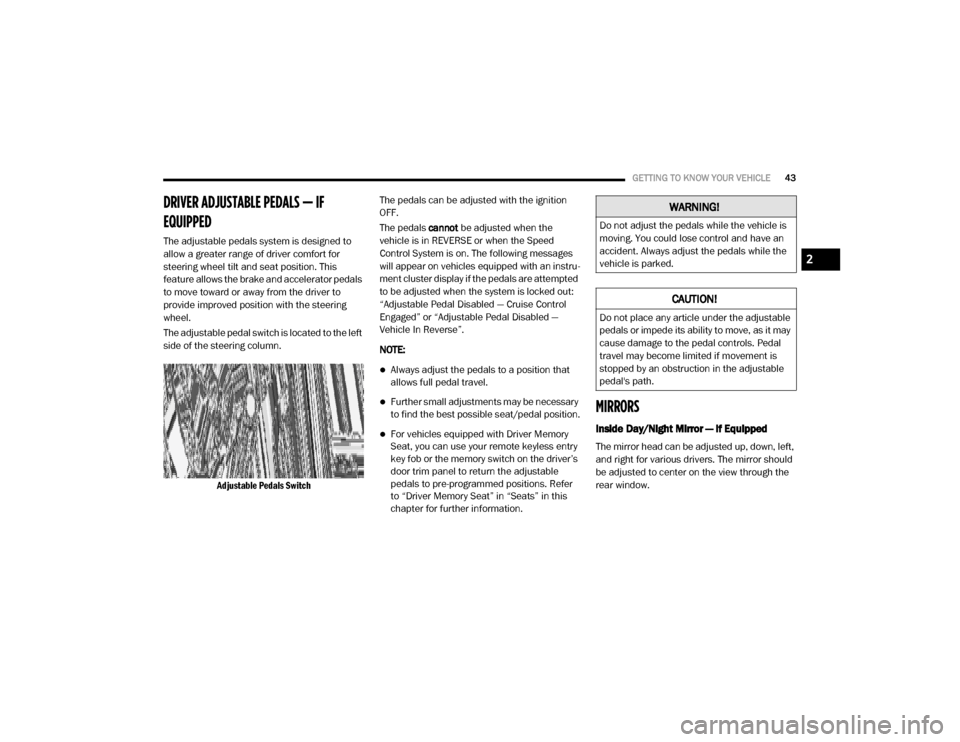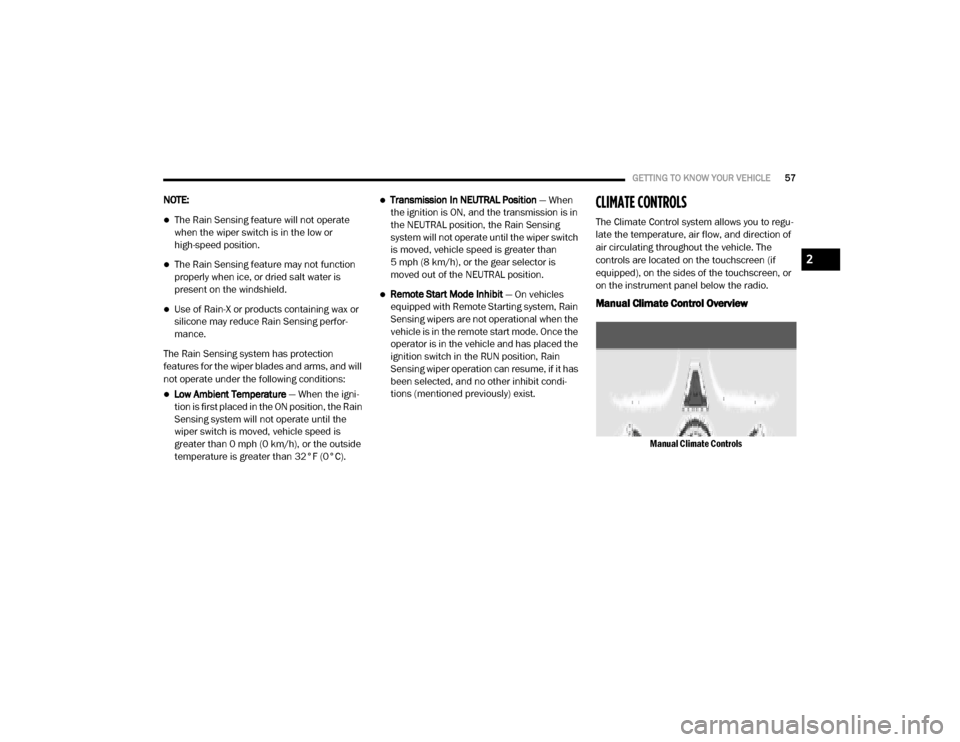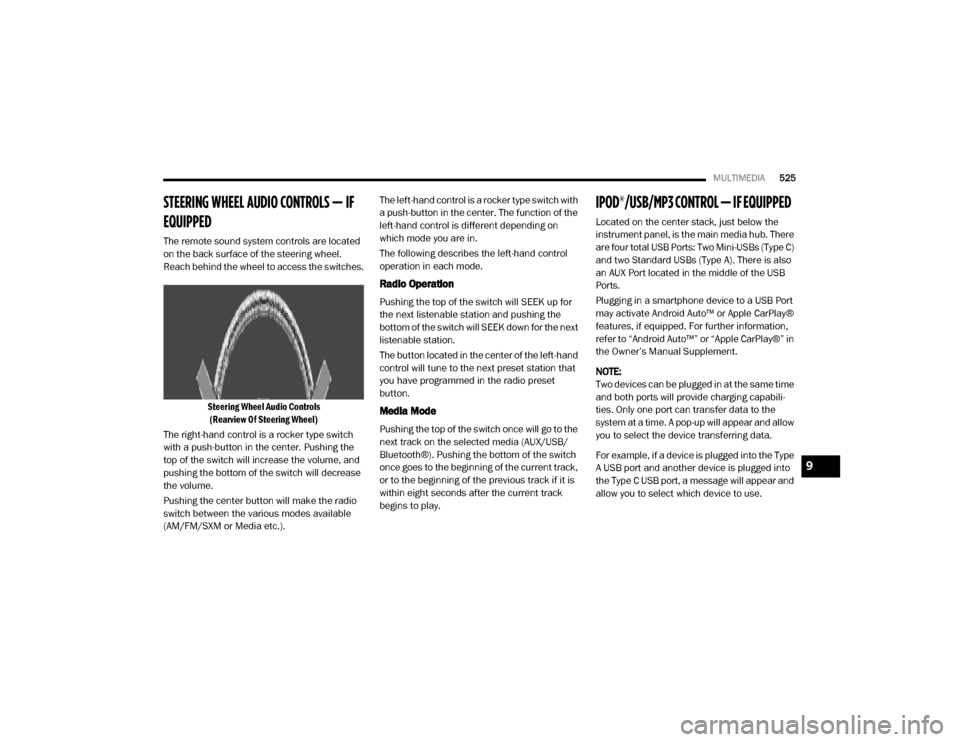remote control Ram 2500 2020 User Guide
[x] Cancel search | Manufacturer: RAM, Model Year: 2020, Model line: 2500, Model: Ram 2500 2020Pages: 553, PDF Size: 21.99 MB
Page 45 of 553

GETTING TO KNOW YOUR VEHICLE43
DRIVER ADJUSTABLE PEDALS — IF
EQUIPPED
The adjustable pedals system is designed to
allow a greater range of driver comfort for
steering wheel tilt and seat position. This
feature allows the brake and accelerator pedals
to move toward or away from the driver to
provide improved position with the steering
wheel.
The adjustable pedal switch is located to the left
side of the steering column.
Adjustable Pedals Switch
The pedals can be adjusted with the ignition
OFF.
The pedals
cannot be adjusted when the
vehicle is in REVERSE or when the Speed
Control System is on. The following messages
will appear on vehicles equipped with an instru -
ment cluster display if the pedals are attempted
to be adjusted when the system is locked out:
“Adjustable Pedal Disabled — Cruise Control
Engaged” or “Adjustable Pedal Disabled —
Vehicle In Reverse”.
NOTE:
Always adjust the pedals to a position that
allows full pedal travel.
Further small adjustments may be necessary
to find the best possible seat/pedal position.
For vehicles equipped with Driver Memory
Seat, you can use your remote keyless entry
key fob or the memory switch on the driver’s
door trim panel to return the adjustable
pedals to pre-programmed positions. Refer
to “Driver Memory Seat” in “Seats” in this
chapter for further information.
MIRRORS
Inside Day/Night Mirror — If Equipped
The mirror head can be adjusted up, down, left,
and right for various drivers. The mirror should
be adjusted to center on the view through the
rear window.
WARNING!
Do not adjust the pedals while the vehicle is
moving. You could lose control and have an
accident. Always adjust the pedals while the
vehicle is parked.
CAUTION!
Do not place any article under the adjustable
pedals or impede its ability to move, as it may
cause damage to the pedal controls. Pedal
travel may become limited if movement is
stopped by an obstruction in the adjustable
pedal's path.
2
20_DJD2_OM_EN_USC_t.book Page 43
Page 59 of 553

GETTING TO KNOW YOUR VEHICLE57
NOTE:
The Rain Sensing feature will not operate
when the wiper switch is in the low or
high-speed position.
The Rain Sensing feature may not function
properly when ice, or dried salt water is
present on the windshield.
Use of Rain-X or products containing wax or
silicone may reduce Rain Sensing perfor -
mance.
The Rain Sensing system has protection
features for the wiper blades and arms, and will
not operate under the following conditions:
Low Ambient Temperature — When the igni-
tion is first placed in the ON position, the Rain
Sensing system will not operate until the
wiper switch is moved, vehicle speed is
greater than 0 mph (0 km/h), or the outside
temperature is greater than 32°F (0°C).
Transmission In NEUTRAL Position — When
the ignition is ON, and the transmission is in
the NEUTRAL position, the Rain Sensing
system will not operate until the wiper switch
is moved, vehicle speed is greater than
5 mph (8 km/h), or the gear selector is
moved out of the NEUTRAL position.
Remote Start Mode Inhibit — On vehicles
equipped with Remote Starting system, Rain
Sensing wipers are not operational when the
vehicle is in the remote start mode. Once the
operator is in the vehicle and has placed the
ignition switch in the RUN position, Rain
Sensing wiper operation can resume, if it has
been selected, and no other inhibit condi -
tions (mentioned previously) exist.
CLIMATE CONTROLS
The Climate Control system allows you to regu -
late the temperature, air flow, and direction of
air circulating throughout the vehicle. The
controls are located on the touchscreen (if
equipped), on the sides of the touchscreen, or
on the instrument panel below the radio.
Manual Climate Control Overview
Manual Climate Controls
2
20_DJD2_OM_EN_USC_t.book Page 57
Page 267 of 553

STARTING AND OPERATING265
not operate the winch without reading and
understanding the complete winch owner's
manual.
Tensioning The Winch Rope
The winch rope must be properly tensioned
before use. Follow the instructions below to
tension the rope:
1. Un-spool the rope leaving five wraps of
rope on the winch drum.
2. Attach the hook to a suitable anchor point.
3. Apply at least 1,000 lbs (454 kg) of tension to the rope while winding the rope. Always
use care to ensure the rope does not pile up
on one side of the drum and is neatly wound
onto the drum.
Low Voltage Interrupt
Your winch is equipped with a device that will
interrupt winch function if the vehicle charging
system voltage drops to a low level. The winch
will not power-in or out for 30 seconds if this
device is tripped. If the interrupt is tripped, the
vehicle should be operated at high idle for a few
minutes to allow the vehicle charging system to
recover before continuing to winch.
Understanding The Features Of Your Winch
Winch Components
1.
Motor:
The winch motor is powered by the
vehicle charging system.
2. Remote Socket: The remote socket (which
will be located on the bumper assembly)
allows the remote control to be attached to the control pack to allow the winch to func
-
tion.
3. Winch Drum With Integral Brake: The winch
drum allows the rope to be stored on the
winch and transmits force to the rope. The
winch is equipped with an integral brake
that will stop rotation of the winch drum if
the winch motor is stopped.
4. Synthetic Rope: The synthetic rope allows
the winch to be connected to an anchor to
provide a pulling force. This synthetic rope is
highly flexible, lightweight, and it floats.
5. Clutch Lever: The clutch lever allows the
winch drum to be disconnected from the
winch motor to allow the rope to be pulled
from the winch by hand.
6. Remote Control: The remote control
provides the interface between the winch
operator and the winch. The remote control
provides the ability to power the winch in,
out, and stop the winch. To operate the
winch, the toggle switch is pressed down to
power the winch in and up to power the
winch out. The winch will stop if the switch
is left in the neutral (center) position.
CAUTION!
Be certain the anchor will withstand the load
required to tension the winch rope.
CAUTION!
The winch rope must spool on the winch
drum in the direction indicated on the drum
rotation decal on the winch.
5
20_DJD2_OM_EN_USC_t.book Page 265
Page 269 of 553

STARTING AND OPERATING267
(Continued)
(Continued)
General Information
Practice using your winch before you get stuck.
Some key points to remember when using your
winch are:
Always take your time to assess the situation
and plan your pull carefully.
Always take your time when using a winch.
Use the right equipment for the situation.
Always wear leather gloves and do not allow
the synthetic rope to slip through your hands
when handling the rope.
Only the operator should handle the synthetic
rope and remote control.
Think safety at all times.
Vehicle Recovery Using The Winch
Always keep hands and clothing clear of the
synthetic rope, hook and fairlead opening
during operation and when spooling.
Never wrap synthetic rope back onto itself.
Always use a choker chain, wire choker
rope or tree trunk protector on the anchor.
Never attach a recovery strap to the winch
hook to increase the length of a pull.
Never attempt to tow a vehicle with the
recovery strap attached directly to the
winch hook.
Never use bungee or kinetic straps that
develop tremendous and potentially
dangerous amounts of force when
stretched.
Always disconnect the remote control when
not in use.
Never winch when there are less than 10
wraps of synthetic rope around the winch
drum.
WARNING!
(Continued)
Always pass remote control through a
window to avoid pinching lead in door,
when using remote inside a vehicle.
Never leave the remote control plugged
into the winch while free spooling, rigging or
sitting idle.
WARNING! (Continued)
CAUTION!
Always know your winch: Take the time to
fully read and understand the included
Installation and Operations Guide, and
Basic Guide to Winching Techniques, in
order to understand your winch and the
winching operation.
Always inspect winch installation and
synthetic rope condition before operating
the winch. Frayed, kinked or damaged rope
must be replaced immediately. Loose or
damaged winch installation must be
corrected immediately.
Always be sure any element which can
interfere with safe winching operations is
removed prior to initiating winching.
Always keep remote control lead clear of
the drum, synthetic rope and rigging.
Inspect for cracks, pinches, frayed rope, or
loose connections. Replace if damaged.
Be careful not to pull the winch rope collar
through the rollers. Watch and listen to
winch for proper snugness.
5
20_DJD2_OM_EN_USC_t.book Page 267
Page 271 of 553

STARTING AND OPERATING269
6. Secure to the anchor point. Once you have
established your anchor point, secure the
tree-trunk protector or choker-chain around
the object.
Tree Trunk Protector
NOTE:
How to choose an anchor point: A secure
anchor is critical to winching operations. An
anchor must be strong enough to hold while
winching. Natural anchors include trees,
stumps and rocks. Hook the cable as low as
possible. If no natural anchors are available
when recovering another vehicle, your vehicle becomes the anchor point. In this case, be sure
to put the transmission in NEUTRAL, apply the
hand brake and block its wheels to prevent your
vehicle from moving. Ideally, you'll want an
anchor point that will enable you to pull straight
in the direction the vehicle will move. This
allows the synthetic rope to wind tightly and
evenly onto the spooling drum. An anchor point
as far away as possible will provide the winch
with its greatest pulling power.
7. Attach the Clevis/D-Shackle and Tree Trunk
Protector. Attach the shackle to the two
ends of the strap or chain and through the
hook, being careful not to over tighten
(tighten and back-off 1/2 turn).
Clevis/D-Shackles
8. Lock the clutch. Lock the winch drum by
rotating the clutch lever on the winch to
engage.
NOTE:
Always ensure the clutch is fully engaged or
disengaged.
9. Connect the remote control to the winch control box, located on the front bumper. Be
careful not to let the remote control cord
dangle in front of the winch. If you choose to
control the winch from inside your vehicle,
always pass the remote through a window
to avoid pinching the cord in the door.
Always disconnect the remote control when
not in use.
Winch Box Remote Control Connector
CAUTION!
Always be certain the anchor you select will
withstand the load.
5
20_DJD2_OM_EN_USC_t.book Page 269
Page 272 of 553

270STARTING AND OPERATING
10. Put synthetic rope under tension. Using the
remote control switch, slowly wind the rope
until no slack remains. Once the rope is
under tension, stand well clear of it and
never step over it.
Pulling Synthetic Rope Under Tension
11. Check your anchor. Make sure all connec -
tions are secured and free of debris before
continuing with the winching procedure.
12. Check synthetic rope. The rope should be neatly wound around the spooling drum.
Improper winding can cause damage to the
synthetic rope.
Synthetic Rope Neatly Wound Around The Spooling
Drum
Heavy Blanket Over Rope
In certain situations you may decide to
throw a heavy blanket or similar object over
the rope. A heavy blanket can absorb ener -
gy should the synthetic rope break. Place it
on the rope midway between the winch and
the anchor point. Do this before the rope is put under tension. Do not approach or move
the blanket once tension is applied. Do not
allow it to get pulled into the fairlead. If it is
necessary to move or remove the blanket,
slack the tension on the rope first.
13. Establish "no people" zones: Make your
intentions clear. Be sure that everyone in
the immediate vicinity surrounding the
winching operation is completely aware of
your intentions before you pull. Declare
where the spectators should not stand —
never behind or in front of the vehicle and
never near the synthetic rope or snatch
block. Your situation may have other "no
people" zones.
No People Zones
20_DJD2_OM_EN_USC_t.book Page 270
Page 273 of 553

STARTING AND OPERATING271
14. Begin winching. With the winching vehicles
engine on and light tension already on the
synthetic rope, begin winching slowly and
steadily. Be sure that the rope is winding
evenly and tightly around the spooling
drum. For additional assistance, the
winched vehicle can be slowly driven while
being pulled by the winch. Continue pulling
until the vehicle is on stable ground. If you
are able to drive the vehicle, the winching
operation is complete.
Using The Remote Control
NOTE:
Avoid overheating the winch motor. For extended winching, stop at reasonable
intervals to allow the winch motor to cool
down.
What to look for under load: The synthetic rope must always spool onto the drum as
indicated by the drum rotation decal on
the winch. As you power-in, make sure
the synthetic rope winds evenly and
tightly on the drum. This prevents the
outer rope wraps from drawing into the
inner wraps, binding and damaging the
synthetic rope. Avoid shock loads by
using the control switch intermittently to
take up rope slack. Shock loads can
momentarily far exceed the winch and
synthetic rope ratings. During side pulls
the synthetic rope tends to stack up at
one end of the drum. This stack can
become large enough to cause serious
damage to the winch. So, line up pulls as
straight ahead as possible and stop
winching if the synthetic rope comes
close to the tie rods or mounting plate. To
fix an uneven stack, spool out that
section of the rope and reposition it to
the opposite end of the drum, which will
free up space for continued winching.
15. Secure vehicle. Once recovery of the vehicle is complete, be sure to secure the vehicle's
brakes and shift the transmission to PARK.
Release tension in the synthetic rope. 16. Disconnect the synthetic rope, and discon
-
nect from the anchor.
17. Rewind the synthetic rope. The person handling the synthetic rope should walk the
rope in and not let it slide through the hand,
control the winch at all times.
Rewinding The Synthetic Rope
WARNING!
To prevent serious injury, NEVER put your
fingers inside the hook area as you are
powering-in.
5
20_DJD2_OM_EN_USC_t.book Page 271
Page 274 of 553

272STARTING AND OPERATING
NOTE:
How to spool under no load: Arrange the remote
control lead so it cannot be caught in the winch.
Arrange the synthetic rope so it will not kink or
tangle when spooled. Be sure any synthetic
rope already on the spooling drum is wound
tightly and evenly layered. Tighten and
straighten the layer if necessary. Keep the
synthetic rope under light tension and spool the
rope back and onto the winch drum in even
layers. Stop frequently to tighten and straighten
the layers as necessary. Repeat this process
until the winch hook is the same distance as the
full length of the remote control from the winch.
Pinch the hook between your thumb and fore -
finger and attach the hook strap. Hold the hook
strap between the thumb and forefinger to keep
tension on the synthetic rope. Walk the
synthetic rope towards the fairlead, carefully
spooling in the remaining rope by pulsing the
remote control switch.
18. Store the hook on the most outboard loop of the hawse fairlead.
Hook In Stored Position
19. Disconnect the remote control. Disconnect the remote control cord from the control box
and store in a clean and dry place. Winching
operations are now complete. Put the cap
on the solenoid plug-in.
NOTE:
Always store the remote control in a protected,
clean, dry area.
Rigging Techniques
Various winching situations will require applica-
tion of other winching techniques. These could
range from too little distance to achieve
maximum pull using straight line rigging, simply
increasing pulling power, or maintaining a
straight-line pulling situation. You will have to assess what technique is correct for your situa
-
tion. Think "safety" at all times.
How To Change The Pulling Direction
Change Pulling Directions
All winching operations should have a straight
line from the winch to the object being pulled.
This minimizes the synthetic rope collecting on
one side of the drum affecting pulling efficiency
and damaging synthetic rope. A snatch block,
secured to a point directly in front of the vehicle
will enable you to change your pulling direction
while still allowing the synthetic rope to be at
90° to wind properly onto the spooling drum.
20_DJD2_OM_EN_USC_t.book Page 272
Page 527 of 553

MULTIMEDIA525
STEERING WHEEL AUDIO CONTROLS — IF
EQUIPPED
The remote sound system controls are located
on the back surface of the steering wheel.
Reach behind the wheel to access the switches.
Steering Wheel Audio Controls(Rearview Of Steering Wheel)
The right-hand control is a rocker type switch
with a push-button in the center. Pushing the
top of the switch will increase the volume, and
pushing the bottom of the switch will decrease
the volume.
Pushing the center button will make the radio
switch between the various modes available
(AM/FM/SXM or Media etc.). The left-hand control is a rocker type switch with
a push-button in the center. The function of the
left-hand control is different depending on
which mode you are in.
The following describes the left-hand control
operation in each mode.
Radio Operation
Pushing the top of the switch will SEEK up for
the next listenable station and pushing the
bottom of the switch will SEEK down for the next
listenable station.
The button located in the center of the left-hand
control will tune to the next preset station that
you have programmed in the radio preset
button.
Media Mode
Pushing the top of the switch once will go to the
next track on the selected media (AUX/USB/
Bluetooth®). Pushing the bottom of the switch
once goes to the beginning of the current track,
or to the beginning of the previous track if it is
within eight seconds after the current track
begins to play.
IPOD®/USB/MP3 CONTROL — IF EQUIPPED
Located on the center stack, just below the
instrument panel, is the main media hub. There
are four total USB Ports: Two Mini-USBs (Type C)
and two Standard USBs (Type A). There is also
an AUX Port located in the middle of the USB
Ports.
Plugging in a smartphone device to a USB Port
may activate Android Auto™ or Apple CarPlay®
features, if equipped. For further information,
refer to “Android Auto™” or “Apple CarPlay®” in
the Owner’s Manual Supplement.
NOTE:
Two devices can be plugged in at the same time
and both ports will provide charging capabili
-
ties. Only one port can transfer data to the
system at a time. A pop-up will appear and allow
you to select the device transferring data.
For example, if a device is plugged into the Type
A USB port and another device is plugged into
the Type C USB port, a message will appear and
allow you to select which device to use.
9
20_DJD2_OM_EN_USC_t.book Page 525
Page 546 of 553

544
J
Jack Location
................................................. 342
Jump Starting................................................ 362
K
Key Fob Panic Alarm
................................................. 15
Programming Additional Key Fobs....... 17, 24
Key Fob Battery Service (Remote Keyless
Entry)
............................................................... 15Key Fob Programming (Remote Keyless
Entry)
............................................................... 17
Keyless Enter-N-Go........................28, 211, 216
Lock The Vehicle’s Doors....... 466, 483, 502
Passive Entry............................................... 28
Passive Entry Programming............. 483, 502
Keys................................................................. 14
Replacement............................................... 24
L
Lane Change And Turn Signals
........................ 52
Lane Change Assist......................................... 52
LaneSense.................................................... 299
Latches.......................................................... 210
Hood........................................................... 74
Lead Free Gasoline........................................ 446
Leaks, Fluid................................................... 210
Life Of Tires................................................... 431
Light Bulbs........................................... 210, 372
Lights............................................................ 210
Air Bag.................................... 130, 181, 209
Automatic High Beam.................................. 50
Brake Assist Warning............................... 148
Brake Warning.......................................... 130
Bulb Replacement.................................... 372
Cab Top Clearance................................... 378Cargo........................................................... 52
Center Mounted Stop............................... 377
Courtesy/Reading....................................... 54Cruise....................................................... 141
Daytime Running......................................... 49
Electronic Stability Program(ESP) Indicator
............................................... 131
Exterior...............................................49, 210Fog........................................................... 376
Four Wheel Drive Indicator....................... 250
Hazard Warning Flasher........................... 338
Headlights............................................ 49, 51High Beam................................................... 50
Hill Descent Control Indicator................... 149
Illuminated Entry......................................... 55
Interior.................................................. 53, 54
Lights On Reminder..................................... 52
Low Fuel................................................... 135
Malfunction Indicator (Check Engine)....... 133
Park.......................................................... 140
Passing........................................................ 51
Seat Belt Reminder.................................. 130
Security Alarm.......................................... 131
Service...................................................... 372
Side Marker.............................................. 379
Traction Control........................................ 148
Transfer Case........................................... 250
Turn Signals............52, 140, 210, 374, 376
Warning Instrument Cluster Descriptions
................................ 131, 140Limited-Slip Differential....................... 264, 418
Load Shed Battery Saver Mode..................... 128
Load Shed Battery Saver On......................... 128Load Shed Electrical Load Reduction........... 128
Load Shed Intelligent Battery Sensor............ 128
Loading Vehicle............................................. 317
Tires.......................................................... 426
LocksAutomatic Door............................................31
Child Protection...........................................31
Power Door..................................................27
Low Tire Pressure System............................. 163Lubrication, Body.......................................... 408
Lug Nuts/Bolts.............................................. 444
M
Maintenance
....................................................74Maintenance Free Battery............................ 395
Maintenance Plan......................................... 386
Maintenance Schedule............... 380, 384, 386
Malfunction Indicator Light (Check
Engine)
................................................. 133, 142
20_DJD2_OM_EN_USC_t.book Page 544